Warning: DOMNode::insertBefore(): Document Fragment is empty in /home/u476767702/domains/eloveshoes.com/public_html/wp-content/plugins/insert-headers-and-footers/includes/class-wpcode-snippet-execute.php(419) : eval()'d code on line 88
Morton’s neuroma is a painful condition caused by the thickening of tissue around the nerves leading to the toes, often resulting in discomfort, tingling, or numbness in the ball of the foot. Finding the right shoes is essential for managing this condition, as proper footwear can reduce pressure, provide support, and alleviate pain. This article highlights the best shoes for Morton’s neuroma, along with tips for choosing the right pair.
What to Look for in Shoes for Morton’s Neuroma
When selecting shoes for Morton’s neuroma, prioritize the following features:
- Adjustability: Shoes with laces, straps, or other adjustable features allow for a customized fit.
- Wide Toe Box: A roomy toe area reduces pressure on the forefoot and prevents compression of the nerves.
- Cushioning: Soft, shock-absorbing insoles help reduce impact on the ball of the foot.
- Arch Support: Proper support distributes weight evenly, reducing stress on the forefoot.
- Low Heel-to-Toe Drop: A flatter sole minimizes pressure on the front of the foot.
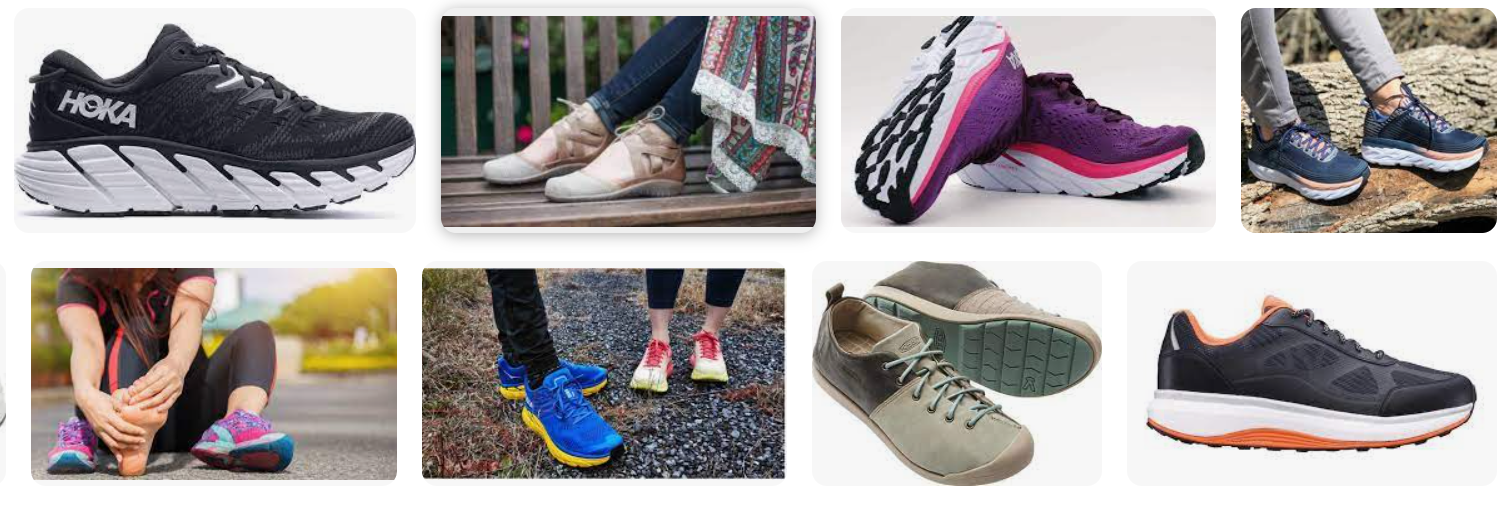
Best Shoes for Morton’s Neuroma
Here are 10 of the best shoes for Morton’s neuroma:
1. Hoka Bondi 8

The Morton’s Neuroma Hoka Bondi 8 shoes are designed to give maximum cushioning and support for patients suffering from Morton’s neuroma. They have a wide toe box for toes to spread out, a 4mm heel drop for less pressure on the forefoot, and a soft, cushioned midsole to absorb impact. The shoes also have a neutral sole, which means there is no arch support built in. This is crucial for patients who have Morton’s neuroma because it can keep the toes from being crushed together.
Key features of the Hoka Bondi 8 Morton’s Neuroma shoes:
- Wide toe box for Morton’s Neuroma relief
- 4mm heel drop to reduce pressure on the forefoot
- Soft and cushioned midsole to absorb impact
- Neutral sole for people with Morton’s Neuroma
- Breathable mesh upper to keep feet cool and comfortable
The Hoka Bondi 8 Morton’s Neuroma shoes are a good choice for people with Morton’s neuroma who are looking for a comfortable and supportive shoe for everyday wear. They are also a good option for people who are prone to foot pain.
Pros and cons of the Hoka Bondi 8 Morton’s Neuroma shoes:
Pros:
- Provides maximum cushioning and support for Morton’s Neuroma
- Wide toe box to allow toes to spread out
- 4mm heel drop to reduce pressure on the forefoot
- Soft and cushioned midsole to absorb impact
- Neutral sole for people with Morton’s Neuroma
- Breathable mesh upper to keep feet cool and comfortable
Cons:
- Can be too bulky for some people
- Not as responsive as some other running shoes
2. Hoka Gaviota 4 shoes
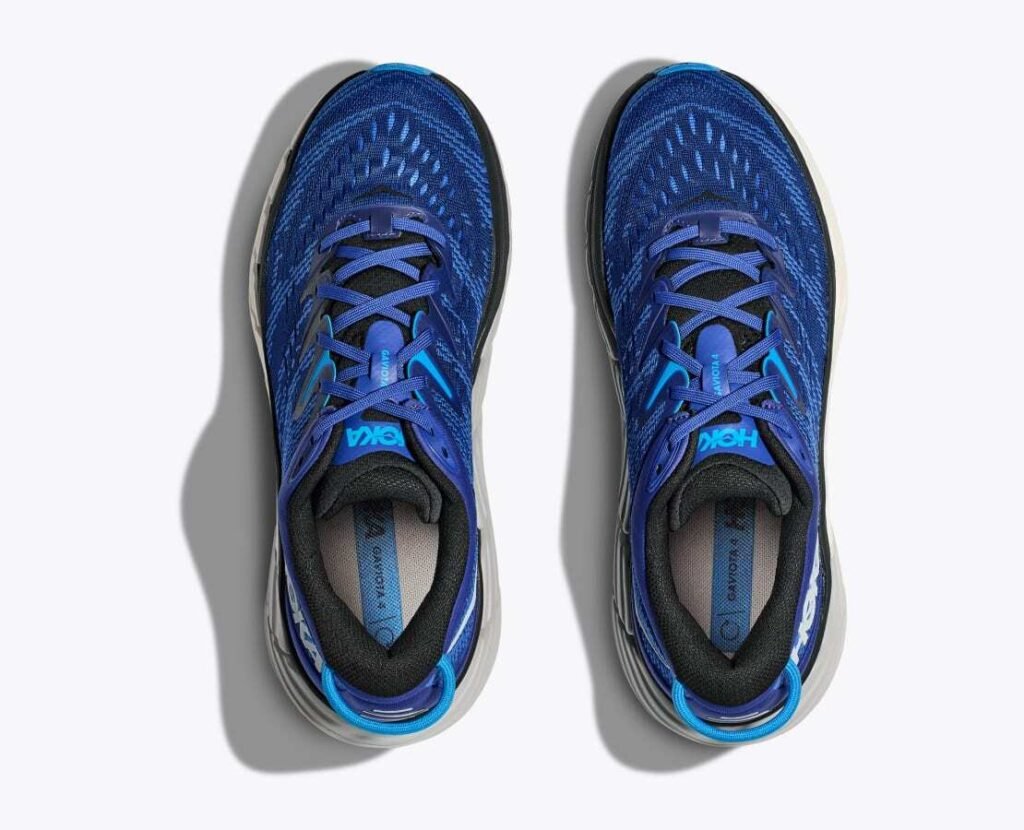
The Hoka Gaviota 4 is a high-end stability running shoe with a soft and supportive ride. It has a larger base and HOKA’s J-Frame technology to assist in avoiding overpronation while not being overly tight. The midsole is comprised of soft, cushioned foam that absorbs impact, and the outsole has long-lasting traction. The upper is constructed of breathable mesh, which keeps your feet cool and comfy.
Key features of the Hoka Gaviota 4:
- J-Frame technology for added stability
- Soft and cushioned midsole
- Durable outsole
- Breathable mesh upper
- Wide base for stability
The Hoka Gaviota 4 is a good choice for runners who are looking for a comfortable and supportive shoe for everyday training. It is also a good option for runners who overpronate.
Pros and cons of the Hoka Gaviota 4:
Pros:
- Plush and supportive ride
- Wide base for stability
- Durable outsole
- Breathable mesh upper
- Good for overpronators
Cons:
- Some runners found that it runs big
- The midsole can be too soft for some runners
3. Skechers Max Cushioning Elite
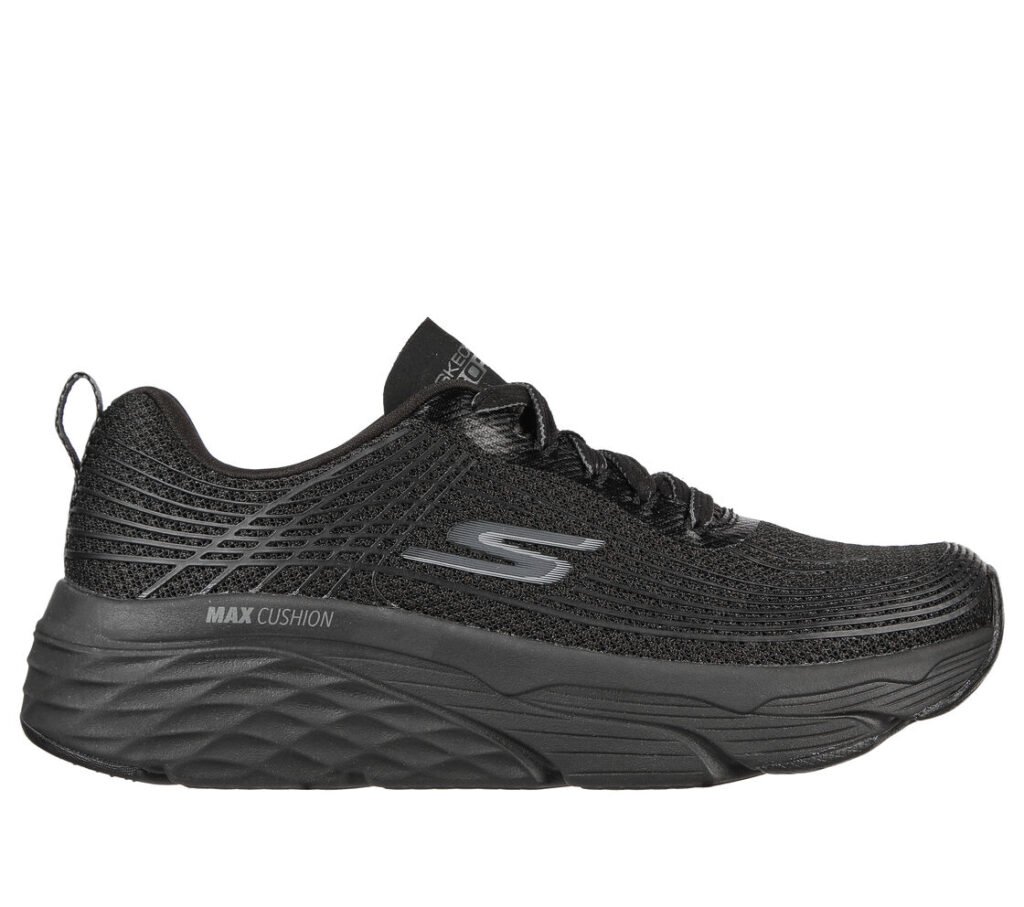
Skechers Max Cushioning Elite Morton’s Neuroma shoes are intended to give maximum cushioning and support for persons suffering from Morton’s neuroma. They have a large toe box that allows the toes to stretch, a 6mm heel drop that relieves pressure on the forefoot, and a soft and cushioned midsole that absorbs impact. The shoes also include a rockered sole, which aids in the promotion of a smooth and efficient gait.
Features of the Skechers Max Cushioning Elite Morton’s Neuroma shoes:
- Wide toe box for Morton’s Neuroma relief
- 6mm heel drop to reduce pressure on the forefoot
- Soft and cushioned midsole to absorb impact
- Rockered sole for smooth and efficient gait
- Breathable mesh upper to keep feet cool and comfortable
The Skechers Max Cushioning Elite Morton’s Neuroma shoes are an excellent choice for persons with Morton’s neuroma who want a comfortable and supportive shoe for everyday use. They are also an excellent choice for folks who suffer from foot problems.
Pros and cons of the Skechers Max Cushioning Elite Morton’s Neuroma shoes:
Pros:
- Provides maximum cushioning and support for Morton’s Neuroma
- Wide toe box to allow toes to spread out
- 6mm heel drop to reduce pressure on the forefoot
- Soft and cushioned midsole to absorb impact
- Rockered sole for smooth and efficient gait
- Breathable mesh upper to keep feet cool and comfortable
Cons:
- Can be a bit bulky for some people
- Not as responsive as some other running shoes
4. Brooks Ghost 14 Shoes

The Brooks Ghost 14 Morton’s Neuroma shoes have been designed to provide cushioning and support to persons suffering from Morton’s neuroma. They have a wide toe box for toes to spread out, a 4mm heel drop for less pressure on the forefoot, and a soft, cushioned midsole to absorb impact. The shoes also have a segmented crash pad, which aids in the transition from landing to toe-off.
Features of the Brooks Ghost 14 Morton’s Neuroma shoes:
- Wide toe box for Morton’s Neuroma relief
- 4mm heel drop to reduce pressure on the forefoot
- Soft and cushioned midsole to absorb impact
- Segmented crash pad for smooth transition
- Breathable mesh upper to keep feet cool and comfortable
The Brooks Ghost 14 Morton’s Neuroma shoes are an excellent solution for those with Morton’s neuroma who want a comfortable and supportive shoe for daily use. They are also an excellent choice for folks who suffer from foot problems.
Pros and cons of the Brooks Ghost 14 Morton’s Neuroma shoes:
Pros:
- Provides cushioning and support for Morton’s Neuroma
- Wide toe box to allow toes to spread out
- 4mm heel drop to reduce pressure on the forefoot
- Soft and cushioned midsole to absorb impact
- Segmented crash pad for smooth transition
- Breathable mesh upper to keep feet cool and comfortable
Cons:
- Some runners found that it runs narrow
- The midsole can be too soft for some runners
5. Saucony Triumph 19

The Saucony Triumph 19 Morton’s Neuroma shoes are designed for patients with Morton’s neuroma to provide optimal cushioning and support. They have a wide toe box for toes to spread out, a 4mm heel drop for less pressure on the forefoot, and a soft, cushioned midsole to absorb impact. The shoes also have a PWRRUN+ midsole that is intended to deliver a smooth and responsive ride.
Features of the Saucony Triumph 19 Morton’s Neuroma shoes:
- Wide toe box for Morton’s Neuroma relief
- 4mm heel drop to reduce pressure on the forefoot
- Soft and cushioned midsole to absorb impact
- PWRRUN+ midsole for a smooth and responsive ride
- Breathable mesh upper to keep feet cool and comfortable
For those with Morton’s neuroma who want a comfortable and supportive shoe for long-distance running, the Saucony Triumph 19 Morton’s Neuroma shoes are a wonderful option. They are a fantastic alternative for those who frequently have foot pain.
Pros and cons of the Saucony Triumph 19 Morton’s Neuroma shoes:
Pros:
- Provides maximum cushioning and support for Morton’s Neuroma
- Wide toe box to allow toes to spread out
- 4mm heel drop to reduce pressure on the forefoot
- Soft and cushioned midsole to absorb impact
- PWRRUN+ midsole for a smooth and responsive ride
- Breathable mesh upper to keep feet cool and comfortable
Cons:
- Can be a bit heavy for some people
- Not as responsive as some other running shoes
6. Asics Gel-Kayano 28 shoes

Gel-Kayano 28 by Asics Morton’s neuroma sufferers can benefit from the stability and cushioning that these shoes offer. Wide toe boxes that let the toes spread out, a 10mm heel drop that relieves pressure on the forefoot, and a soft, cushioned midsole that absorbs impact are all features of these shoes. The GuideRail system, which aids in stabilizing the foot and controlling overpronation, is another feature of the shoes.
Key features of the Asics Gel-Kayano 28 Morton’s Neuroma shoes:
- Wide toe box for Morton’s Neuroma relief
- 10mm heel drop to reduce pressure on the forefoot
- Soft and cushioned midsole to absorb impact
- GuideRail system for stability
- Breathable mesh upper to keep feet cool and comfortable
The Asics Gel-Kayano 28 is a running shoe. Morton’s Neuroma shoes are a fantastic option for persons who have Morton’s neuroma and want a solid and supportive shoe for everyday use. They are also an excellent choice for persons who tend to overpronate.
Pros and cons of the Asics Gel-Kayano 28 Morton’s Neuroma shoes:
Pros:
- Provides stability and cushioning for Morton’s Neuroma
- Wide toe box to allow toes to spread out
- 10mm heel drop to reduce pressure on the forefoot
- Soft and cushioned midsole to absorb impact
- GuideRail system for stability
- Breathable mesh upper to keep feet cool and comfortable
Cons:
- Can be a bit heavy for some people
- Not as responsive as some other running shoes
7. New Balance 1080v12
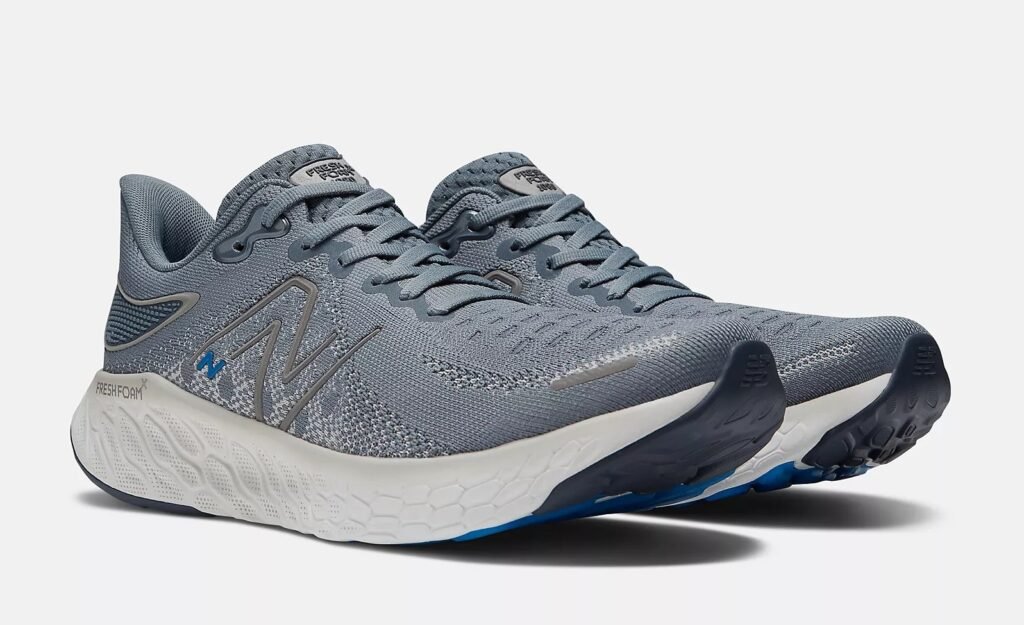
The New Balance 1080v12 Morton’s Neuroma shoes are designed to provide cushioning and support for people with Morton’s neuroma. They feature a wide toe box to allow the toes to spread out, an 8mm heel drop to reduce pressure on the forefoot, and a soft and responsive midsole to absorb impact. The shoes also have a Fresh Foam midsole, which is made of lightweight and bouncy foam that provides a smooth and comfortable ride.
Key features of the New Balance 1080v12 Morton’s Neuroma shoes:
- Wide toe box for Morton’s Neuroma relief
- 8mm heel drop to reduce pressure on the forefoot
- Soft and responsive Fresh Foam midsole
- Breathable mesh upper to keep feet cool and comfortable
- Internal heel counter for support
The 1080v12 by New Balance Morton’s Neuroma shoes are a fantastic option for persons who have Morton’s neuroma and want a comfortable and supportive shoe for everyday use. They are also an excellent choice for folks who suffer from foot problems.
Pros and cons of the New Balance 1080v12 Morton’s Neuroma shoes:
Pros:
- Provides cushioning and support for Morton’s Neuroma
- Wide toe box to allow toes to spread out
- 8mm heel drop to reduce pressure on the forefoot
- Soft and responsive Fresh Foam midsole
- Breathable mesh upper to keep feet cool and comfortable
- Internal heel counter for support
Cons:
- Some runners found that it runs narrow
- Not as durable as some other running shoes
8. Vionic Women Joey Lace-Up Shoes
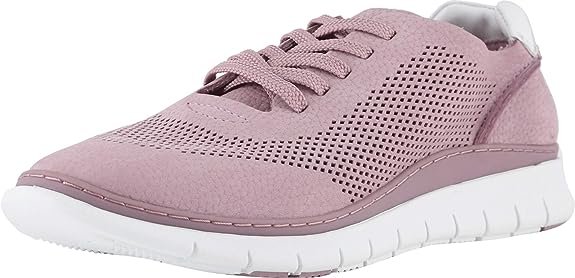
The Vionic Women Joey Lace-Up Shoes are intended to provide comfort and support to persons suffering from Morton’s neuroma. They have a large toe box to allow the toes to spread out, a 4mm heel drop to relieve pressure on the forefoot, and a cushioned midsole to absorb impact. The shoes also feature an arch support built in to assist in straightening the foot and relieving pain.
Key features of the Vionic Women Joey Lace-Up Shoes:
- Wide toe box for Morton’s Neuroma relief
- 4mm heel drop to reduce pressure on the forefoot
- Cushioned midsole to absorb impact
- Built-in arch support
- Breathable mesh upper to keep feet cool and comfortable
- Flexible outsole for natural movement
The Vionic Women Joey Lace-Up Shoes are an excellent solution for persons with Morton’s neuroma who want a comfortable and supportive shoe for daily use. They are also an excellent choice for folks who suffer from foot problems.
Pros and cons of the Vionic Women Joey Lace-Up Shoes:
Pros:
- Provides comfort and support for Morton’s Neuroma
- Wide toe box to allow toes to spread out
- 4mm heel drop to reduce pressure on the forefoot
- Cushioned midsole to absorb impact
- Built-in arch support
- Breathable mesh upper to keep feet cool and comfortable
- Flexible outsole for natural movement
Cons:
- Some people found that the shoes run narrow
- Not as stylish as some other shoes
9. ECCO WOMEN’S SOFT 7 SNEAKER
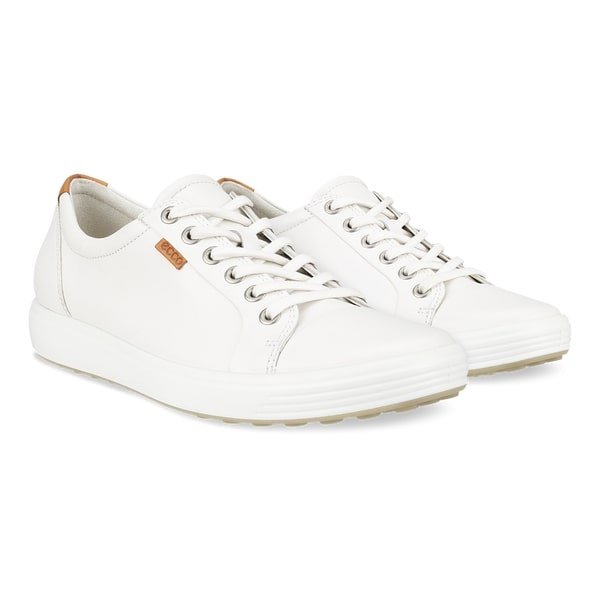
The ECCO Women’s Soft 7 Sneaker is a fashionable and comfy sneaker that is also intended to help persons suffering from Morton’s neuroma. The shoe has a broad toe box to allow the toes to spread out and relieve pressure on the nerve. It also features a cushioned midsole for impact absorption and a flexible outsole for natural movement.
Key features of the ECCO Women’s Soft 7 Sneaker:
- Wide toe box for Morton’s Neuroma relief
- Cushioned midsole to absorb impact
- Flexible outsole for natural movement
- Breathable mesh upper to keep feet cool and comfortable
- Removable OrthoLite insole for added comfort
The ECCO Women’s Soft 7 Sneaker is a fantastic solution for persons with Morton’s neuroma who want to wear a comfortable and fashionable sneaker all day. It is also an excellent choice for persons who suffer from foot pain.
Pros and cons of the ECCO Women’s Soft 7 Sneaker:
Pros:
- Provides relief for Morton’s Neuroma
- Wide toe box for comfort
- Cushioned midsole for impact absorption
- Flexible outsole for natural movement
- Breathable mesh upper for breathability
- Removable OrthoLite insole for added comfort
Cons:
- Some people found that the shoes run narrow
- Not as durable as some other shoes
Morton’s Neuroma Symptoms & Diagnosis
Symptoms:
The common symptoms of Morton’s Neuroma include:
- Pain: This is typically felt on the ball of the foot, especially when putting weight on it. The pain can be sharp, burning, or a cramping sensation.
- Numbness or Tingling: People often describe the sensation as feeling like there’s a pebble in their shoe. There might also be numbness, tingling, or a burning sensation radiating to the toes.
- Swelling: There might be swelling between the toes or on the ball of the foot.
- Pain when walking: The pain can be aggravated by wearing tight or narrow shoes, or by activities that put pressure on the ball of the foot, such as running or walking.
Diagnosis:
If you suspect you have Morton’s Neuroma, it’s important to see a healthcare provider, preferably a podiatrist or orthopedic specialist. The diagnostic process may include:
- Physical Examination: The doctor will palpate (feel) the foot to identify areas of tenderness. There’s a specific maneuver called the Mulder’s click, where squeezing the sides of the foot while pressing on the area of pain might produce a click, which is a sign of Morton’s Neuroma.
- Medical History: Discussing your symptoms and any potential risk factors or causes can help in the diagnosis.
- Imaging Studies:
- X-rays: While Morton’s Neuroma doesn’t show up on an X-ray, it can help rule out other causes of foot pain, like fractures or arthritis.
- Ultrasound: This imaging can visualize soft tissues and can be used to detect the neuroma.
- Magnetic Resonance Imaging (MRI): While it’s more expensive and often not the first choice, an MRI can provide detailed images and confirm the presence of a neuroma.
Risk Factors:
While anyone can develop Morton’s Neuroma, certain risk factors increase the likelihood:
- Foot Deformities: People with flat feet, high arches, bunions, or hammertoes might be at a higher risk.
- Ill-fitting Shoes: Tight, narrow shoes, especially high heels, can compress the toes and exacerbate the condition.
- Repetitive Activities: Engaging in high-impact athletic activities, such as jogging or running, can subject your feet to repetitive trauma.
- Injuries: Previous foot or toe injuries might make you more susceptible to Morton’s Neuroma.
Morton’s Neuroma Facts and Stats
- Women experience Morton’s neuroma 8–10 times more than men.
- Morton’s neuroma most commonly occurs between the third and fourth toes of the foot.
- The best shoes for neuroma and bunions alike are those with plenty of cushions and a wide-toe box for a comfortable fit.
Here are some additional tips for choosing shoes for Morton’s neuroma:
- Try on shoes at the end of the day, when your feet are the most swollen.
- Walk around in the shoes for a few minutes to make sure they are comfortable.
- Look for shoes that have a flexible sole.
- Avoid shoes with a high heel or pointed toe.
FAQ:
A: Morton’s Neuroma gives the foot a stinging and burning sensation due to the swelling of the tissue surrounding one of the nerves leading to the toes.
A: Shoes best suited for Morton’s Neuroma provide ample cushioning, have a roomy toe box, and are available in wide widths to offer your joints, nerves, and metatarsals enough space.
A: Yes, Morton’s Neuroma can progress to a stage where surgery is needed. However, conservative therapy and selecting the right footwear can help manage and even prevent this painful foot condition.
A: Yes, the Mayo Clinic is a trusted source for information related to Morton’s Neuroma.
A: The content mentions a list of the best 10 supportive and relieving shoes for Morton’s neuroma, but specific names or brands are not provided.
A: Morton’s Neuroma is often caused by the tissue surrounding one of the nerves leading to the toes swelling. This results in a painful ailment that typically affects the third and fourth toes on the ball of the foot.

Comments are closed.